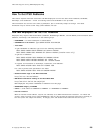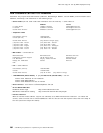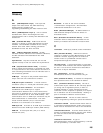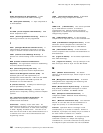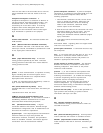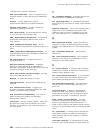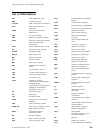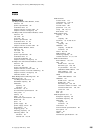This soft copy for use by IBM employees only.
Standard used in France and Russia.
SDU (Service Data Unit). Data as it appears at the
interface between a layer and the layer immediately
above.
segment. A single ATM link or group of
interconnected ATM links of an ATM connection.
signaling virtual channel. A virtual channel for
transporting signaling information.
SLIP (Serial Line IP). An IETF Standard for running
IP over serial line communication links.
SNA (System Network Architecture). A networking
architecture developed by IBM currently used for
large systems.
SNAP (SubNetwork Attachment Point). An LLC
header extension that identifies the protocol type of a
frame.
SNMP (Simple Network Management Protocol). An
IETF Standard protocol that uses MIBs to control and
monitor network elements.
SR (Source Routing). A bridging protocol for
Token-Ring LANs.
SRT (Source Routing Transparent). A bridging
protocol for LANs specified in the IEEE 802.1d
Standard. SRT bridges support both source-route and
transparent bridging on the same port.
SR-TB (Source Route Transparent Bridge). A bridge
that connect SR and SRT ports
Sublayer. A logical sub-division of a layer.
switched connection. A connection established by
signaling.
SVC (switched virtual circuit). A logical (not
physical) connection established between two ATM
stations on demand using signalling.
SVN (Switched Virtual Networking). The name of
IBM′s framework for building and managing
switch-based networks.
synchronous. Literally “locked together”. When two
bit streams are said to be synchronous it is meant
that they are controlled by the same clock and are in
the same phase.
T
TB (Transparent bridging). A bridging protocol for
LANs specified in the IEEE 802.1d Standard.
TLV (Type/length/value). A generalized information
element that may be present in certain LAN emulation
packets.
telephone twisted pair. One or more twisted pairs of
copper wire in the unshielded voice-grade cable
commonly used to connect a telephone to its wall
jack. Also referred to as “unshielded twisted pair”
U
UBR (Unspecified Bit Rate). ATM Forum Service
category in relation to traffic Management on ATM
networks. The UBR service is for ″best effort″ delivery
of data.
UTP (unshielded twisted pair). See
telephone
twisted pair
.
UNI (User to Network Interface). The connection
that links a user device to an ATM switch, hence
attaches it to the ATM network.
V
VC (Virtual Channel). A concept used to describe
unidirectional transport of ATM cells associated by a
common unique identifier value.
VCC (Virtual Channel Connection). A concatenation
of virtual channel links that extends between two
points where the adaptation layer is accessed.
VCI (Virtual Channel Identifier). The VPI/VCI pair
uniquely identify a specific ATM connection on a
given link.
virtual channel link. A means of unidirectional
transport of ATM cells between a point where a
virtual channel identifier value is assigned and the
point where that value is translated or removed.
VLAN (Virtual Local Area Network). A logical
collection of ATM stations grouped into a single
domain, and independent of physical location. A
VLAN is often based on end stations having common
access to a LAN emulation server or Classical IP ARP
server.
VP (Virtual Path). A concept used to describe the
unidirectional transport of ATM cells belonging to
virtual channels that are associated by a common
identifier value.
virtual path connection. A concatenation of virtual
path links that extends between the point where the
288 ATM Workgroup Solutions: Implementing the 8285 ATM Switch




